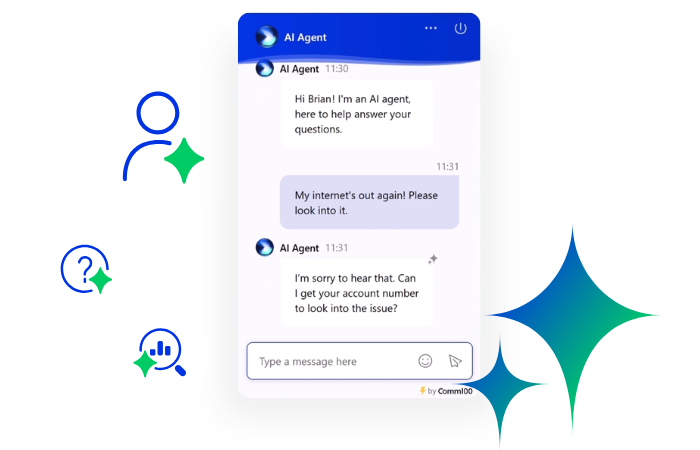AI-powered
chatbots are so 2018. This year, it’s all about agent-facing AI.
The ironic thing about this statement is that it makes it sound like agent-facing AI is just a fad. No doubt there has been a lot of talk about how AI can be used to help improve customer-facing interactions – but there’s more to AI than meets the eye.
Truth
be told, internal uses of AI have just as much disruptive power as chatbots if
not more – and are also far simpler to deploy and far quicker to generate
positive ROI.
Support agents are the de facto front-line of any company’s customer experience (CX). However with costly onboarding and training costs and high turnover, contact centers struggle to build excellent agent experiences. Internal AI can turn that all around and supercharge contact center agents so they’re faster, more knowledgeable, and more efficient.
Here
are 3 reasons why agent-facing AI is so perfect for today’s contact centers.
What is Agent-facing AI?
Let’s
start with defining what we’re talking about. Agent-facing AI refers to any AI
technology deployed for use by your contact center agents. This is in contrast
to chatbots, which are customer facing.
There are currently 2 primary types of agent-facing AI: analytics tools that help paint a picture of the customer by combing through terabytes of data stored across multiple systems, and conversational applications that help agents better understand and handle customer inquiries. The former is all about business intelligence whereas the latter is all about front-line assistance, be that tools like predictive routing, sentiment analysis, and resource discovery.
It’s
on this latter area that I’m going to focus because I believe this is where AI
stands to make the biggest impact. This
form of AI integrates your customer communication channels with existing
knowledge resources to present answers to agents when they need
them.
Equipped with NLP and Machine Learning capabilities, agent-facing AI (we call ours Agent Assist) works by scanning text-based customer conversations and providing answer suggestions from your internal or external knowledge bases, chatbot intents and other standardized responses built into your digital omnichannel platform. These systems can even learn from its interactions, building a response model based on the answers chosen by your agents.
Just as you have everything you need to drive your car while sitting in the driver’s seat, putting key resources where agents can easily see them is essential. Agent Assist suggestions are embedded right inside the agent console so your team no longer has to search for answers.
The FAQ Destroyer
Put yourself in one of
your new agent’s shoes for a moment. You’ve undergone all requisite
training and are ready to start fielding customer queries. The harder ones
will take some time before you fully get the hang of it. These queries fall
into the gray area where a good answer starts with “Well, it depends
on…”
For most other queries the answers
are more black and white. When it comes to getting comfortable with
basic FAQs and straightforward inquiries, you’ll quickly be able
to share answers from memory, either by retyping them from scratch each time or
finding that bookmarked link to a related resource. You will get faster with
time but even the most senior agents still have to wait to read the inbound
message before they can act. Then, searching a canned message library or
knowledge base adds yet more time.
Agent-facing AI like our Agent Assist
skips over that process by screening the inbound inquiry and surfacing the
right answer for the agent to then modify or send along as-is with a simple
click of the mouse.
Eliminating Friction in the Agent Experience
We often talk about the necessity
of eliminating friction in the customer experience, but we
rarely think about what the equivalent might mean for employees.
It’s a reality that for many customer-facing
employees, getting the right answer to even black-and-white questions might
mean consulting an FAQ page,scouring paper-based manuals, searching
an online knowledge base, and finally asking other colleagues, all the while
knowing the customer is getting more irate the longer they’re on
hold.
The beauty of integrating agent-facing
AI with your communication system is that you can draw on the
combined wisdom of all of these resources and let the AI do all the
searching, faster and more comprehensively than a human can. Even in
situations that require more technical troubleshooting, it will put all
relevant resources at your agents’ fingertips. Old products or new, veteran
agents or rookies – everyone will benefit from faster, easier access to more
information.
The start of an automation journey
Agent-facing AI is a low-risk way to
get started with automation and deepen your internal knowledge resources. Since
these resources are key to building effective chatbots, the possibilities for
further automation then unfold.
Chatbots not for you? This AI
application can also be used to automate specific workflows – such as tracking
an order, resetting a password, or making a payment. Any process that requires
multiple, predictable, and standardized steps can be initiated by your agents,
who can then take back control when the customer completes the
workflow.
Wrap-up
Humans will always be essential to the customer experience. There will never be a complete replacement for that. But contact centers can improve the way they support and develop them to fulfill the vital roles they will play in the customer journey. AI applications like Agent Assist are a critical resource in this pursuit, alongside proper training, monitoring and feedback, and ongoing development.
While AI may (never?) be able to coach, mentor or grow authentic human relationships, it’s possible for them now to shoulder enough of the customer service load so your agents can have more time to focus on the harder stuff. And that’s ultimately the promise of AI adoption: to allow us humans to better exercise our uniquely human skills, and to free us from basic, repetitive, transactional work so we can invest in the things that truly matter.
AI and Bots: Are you ready?
Discover the most promising bot and AI technologies available today and how each can contribute to better customer care and agent productivity.
Watch the recording
Webinar







